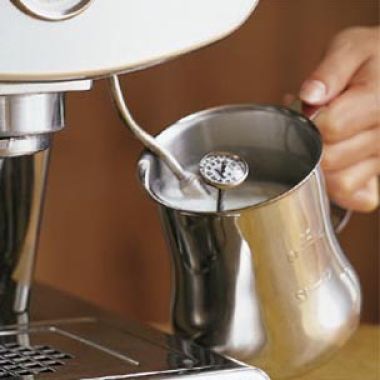
Creating frothed milk for topping lattes, cappuccinos and other espresso drinks is easy when you use a home espresso machine or frother. With a bit of practice, you will be steaming pitchers of creamy foam in no time.
Be sure you have the proper equipment, including a stainless-steel pitcher large enough so the milk can triple in volume. You will also need a thermometer, the kind that slips into a plastic sleeve and hooks onto the side of the pitcher. Then check the tiny hole at the end of the steam wand and clear any obstruction with a straight pin.
To produce the densest foam, use skim milk rather than 2% or whole milk. Be sure both the milk and the pitcher are cold, a key to successful frothing. (You can store the empty pitcher in your freezer so it is ready at a moment's notice.)
Now you are ready to begin frothing:
1. Fill the pitcher no more than one-third full with cold milk. Because milk foams only when it is cold, you want to create the foam before heating the milk. Place the tip of the steam wand about 1/2 inch below the surface of the milk, then open the valve and tilt the pitcher to create a whirlpool. As the milk takes in air, you will hear an intermittent hissing sound. When the milk rises and dense foam is created, continue to lower the pitcher, and be sure to keep the tip of the steam wand just below the surface of the milk.
2. When the milk reaches about 110°F, plunge the steam wand deep into the milk to heat it. Optimum temperature is 140° to 160°F. (Milk scalds at 180°F.)
3. Let the frothed milk stand for about 30 seconds, then spoon it onto the espresso drinks.
Be sure to wipe off the steam wand immediately after using it.
Be sure you have the proper equipment, including a stainless-steel pitcher large enough so the milk can triple in volume. You will also need a thermometer, the kind that slips into a plastic sleeve and hooks onto the side of the pitcher. Then check the tiny hole at the end of the steam wand and clear any obstruction with a straight pin.
To produce the densest foam, use skim milk rather than 2% or whole milk. Be sure both the milk and the pitcher are cold, a key to successful frothing. (You can store the empty pitcher in your freezer so it is ready at a moment's notice.)
Now you are ready to begin frothing:
1. Fill the pitcher no more than one-third full with cold milk. Because milk foams only when it is cold, you want to create the foam before heating the milk. Place the tip of the steam wand about 1/2 inch below the surface of the milk, then open the valve and tilt the pitcher to create a whirlpool. As the milk takes in air, you will hear an intermittent hissing sound. When the milk rises and dense foam is created, continue to lower the pitcher, and be sure to keep the tip of the steam wand just below the surface of the milk.
2. When the milk reaches about 110°F, plunge the steam wand deep into the milk to heat it. Optimum temperature is 140° to 160°F. (Milk scalds at 180°F.)
3. Let the frothed milk stand for about 30 seconds, then spoon it onto the espresso drinks.
Be sure to wipe off the steam wand immediately after using it.
Williams-Sonoma Kitchen.












